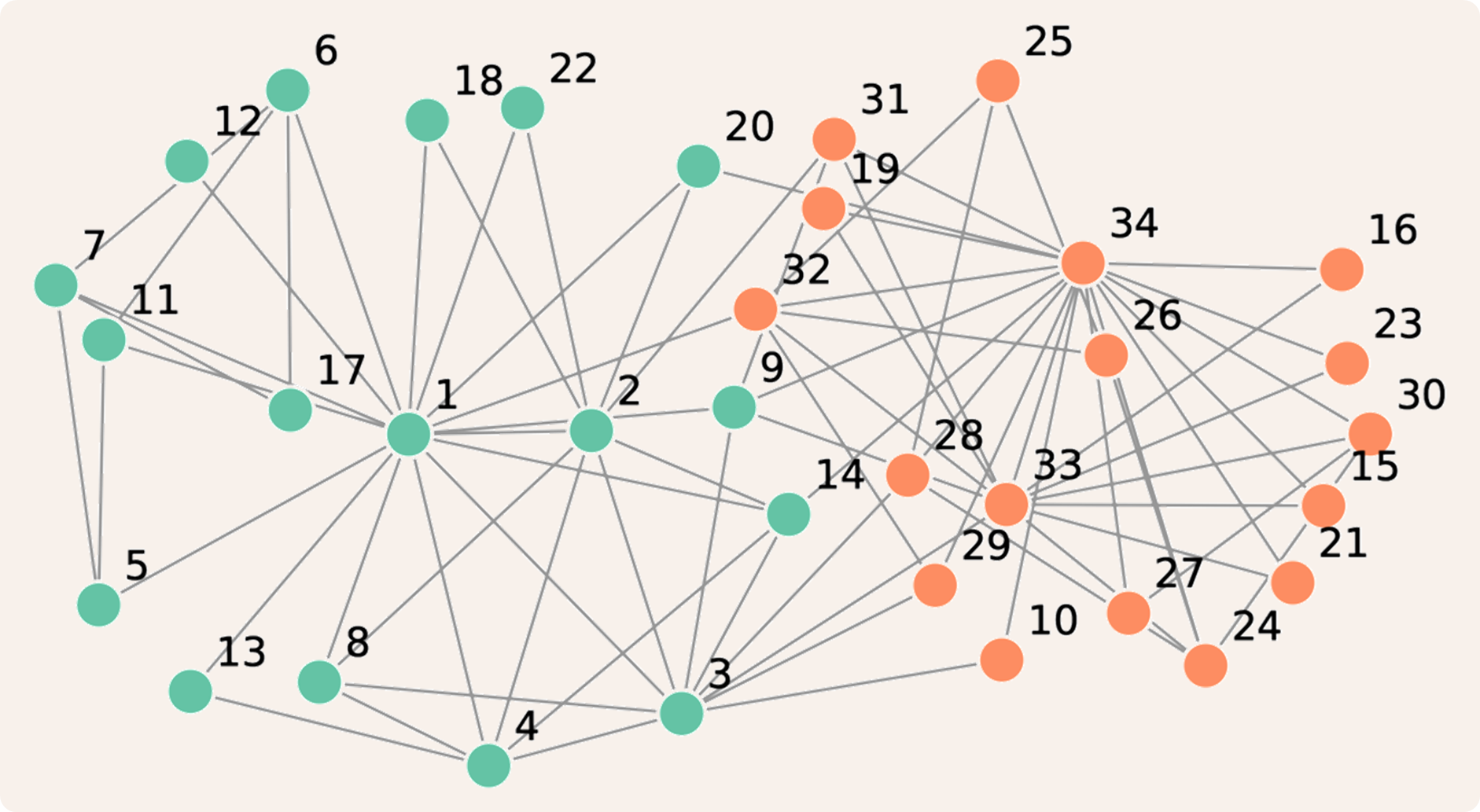Temple University1 anthropologist Wayne Zachary was studying a local karate club in the early 1970s when a disagreement arose between the club’s instructor and its president, dividing the club’s 34 members into two factions. By studying the communication flow among the members, Zachary was able to predict correctly, with one exception, which side each member would take in the dispute between the club's instructor and its president.

This episode has become a popular example in discussions of community structure in networks, so much so that scientists now award a trophy to the first person to use it at a conference. The original example is known as Zachary’s Karate Club; the trophy winners are the Zachary’s Karate Club Club2.
Assignment
In a network $$\mathcal{N}$$ with $$n$$ nodes, the nodes are numbered from 1 to $$n$$. The capacity $$c_{i,j}$$ is a measure of the strength of the communication flow between node $$i$$ and node $$j$$ in network $$\mathcal{N}$$: the higher the capacity, the stronger the communication flow between the two nodes. We only consider networks whose capacities satisfy the following conditions:
-
$$c_{i,j} \in \mathbb{N}$$, with $$0 \leq c_{i,j} < 10$$ for all $$1 \leq i, j \leq n$$
-
$$c_{i,j} = c_{j,i}$$ for all $$1 \leq i, j \leq n$$
-
$$c_{i,i} = 0$$ for all $$1 \leq i \leq n$$
A capacity file for a network $$\mathcal{N}$$ is a text file that describes all capacities of the network. The file contains $$n$$ lines that each consist of $$n$$ digits (0–9). If we number the lines from top to bottom starting at 1, and also number the positions of the digits on each line from left to right starting at 1, then the $$j$$-th digit on line $$i$$ represents the capacity $$c_{i,j}$$ of network $$\mathcal{N}$$. For example, this is the capacity file for the 34 members of Zachary's Karate Club (karate.txt3):
0453333220232300020202000000000200 4063000400000500010202000000002000 5603000451000300000000000002200030 3330000300003300000000000000000000 3000002000300000000000000000000000 3000005000300000300000000000000000 3000250000000000300000000000000000 2443000000000000000000000000000000 2050000000000000000000000000003043 0010000000000000000000000000000002 2000330000000000000000000000000000 3000000000000000000000000000000000 2003000000000000000000000000000000 3533000000000000000000000000000003 0000000000000000000000000000000032 0000000000000000000000000000000034 0000033000000000000000000000000000 2100000000000000000000000000000000 0000000000000000000000000000000012 2200000000000000000000000000000001 0000000000000000000000000000000031 2200000000000000000000000000000000 0000000000000000000000000000000020 0000000000000000000000000504020054 0000000000000000000000000203000200 0000000000000000000000052000000700 0000000000000000000000000000040002 0020000000000000000000043000000004 0020000000000000000000000000000202 0000000000000000000000020040000042 0200000030000000000000000000000033 2000000000000000000000002700200044 0030000040000033001030250000043405 0000000032000324002110340024223450
A group of nodes of a network $$\mathcal{N}$$ with $$n$$ nodes is a collection (list, tuple or set) containing the node numbers (int). As such, the collection may only consist of integers between 1 and $$n$$. Moreover, each node number may occur at most once in the collection. The order of the node numbers in the collection plays no role.
Your task:
-
Write a function read_network that takes the location (str) of a capacity file for a network $$\mathcal{N}$$. The function must return a dictionary (dict) that maps each node $$i$$ (int) in network $$\mathcal{N}$$ onto a dictionary (dict) that maps each node $$j$$ (int) for which $$c_{i,j} > 0$$ in network $$\mathcal{N}$$ onto the capacity $$c_{i,j}$$ (int) of network $$\mathcal{N}$$. The result returned by this function is called the capacity dictionary of network $$\mathcal{N}$$.
-
Write a function complementary_group that takes two arguments: i) a group $$g$$ (list, tuple or set) with nodes (int) of a network $$\mathcal{N}$$ and ii) the capacity dictionary (dict) of network $$\mathcal{N}$$. If the first argument does not represent a valid group, the function must raise an AssertionError with message invalid group. Otherwise, the function must return the complementary group $$\bar{g}$$: a set (set) with all nodes (int) of network $$\mathcal{N}$$ that do not belong to group $$g$$.
-
Write a function flow that takes two arguments: i) a group $$g$$ (list, tuple or set) with nodes (int) of a network $$\mathcal{N}$$ and ii) the capacity dictionary (dict) of network $$\mathcal{N}$$. If the first argument does not represent a valid group, the function must raise an AssertionError with message invalid group. Otherwise, the function must return the strength of the communication flow (int) between group $$g$$ and its complementary group $$\bar{g}$$: the sum of all capacities $$c_{i,j}$$ for all $$i \in g$$ and all $$j \in \bar{g}$$.
Example
In this interactive session we assume the text file karate.txt4 to be located in the current directory.
>>> network = read_network('karate.txt5')
>>> network[11]
{1: 2, 5: 3, 6: 3}
>>> network[24]
{26: 5, 28: 4, 30: 2, 33: 5, 34: 4}
>>> group = [1, 2, 3, 4, 5, 6, 7, 8, 11, 12, 13, 14, 17, 18, 20, 22]
>>> complementary_group(group, network) # doctest: +SKIP
{9, 10, 15, 16, 19, 21, 23, 24, 25, 26, 27, 28, 29, 30, 31, 32, 33, 34}
>>> complementary_group((1, 2, 3, 2), network)
Traceback (most recent call last):
AssertionError: invalid group
>>> flow(group, network)
23
>>> flow(set(group) | {9}, network)
26
>>> flow((1, 2, 3, 2), network)
Traceback (most recent call last):
AssertionError: invalid group
Epilogue
The person who Zacharay assigned to the wrong faction corresponds to node 9 in the network depicted in the introduction of this assignment. This person joined the newly founded karate club with supporters of the teacher (node 1) after the split, despite being a weak supporter of the president (node 34). This choice stemmed mainly from opportunism: he was only three weeks away from a test for black belt (master status) when the split in the club occurred. Had he joined the president's club, he would have had to give up his rank and begin again in a new style of karate with a white (beginner's) belt, since the president had decided to change the style of karate practiced in his club. Having four years of study invested in the style of the original club's instructor, the individual could not bring himself to repudiate his rank and start again.